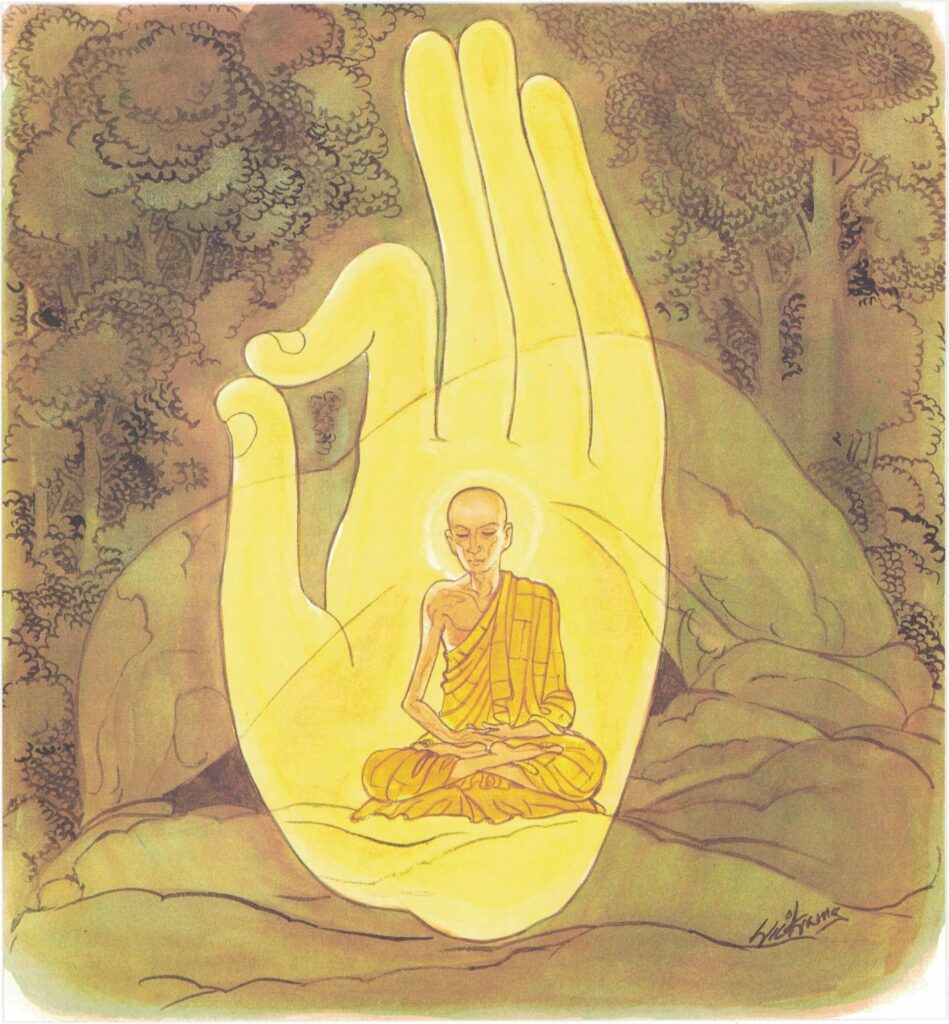Pali text, illustration and English translation of Dhammapada verse 395:
paṃsukūladharaṃ jantūṃ kisaṃ dhamanisanthataṃ |
ekaṃ vanasmiṃ jhāyantaṃ tamahaṃ brūmi brāhmaṇaṃ || 395 ||
395. One enduring rag-robes, lean, with body o’erspread by veins, lone in the woods who meditates, that one I call a Brāhmin True.

The Story of Kisā Gotamī, Wearer of Refuse-Rags
This religious instruction was given by the Buddha while he was in residence at Mount Vulture Peak, with reference to Kisā Gotamī.
For at that time, at the end of the first watch, Sakka, attended by a host of deities, drew near the Buddha, saluted him, sat down respectfully on one side, and listened to him as he preached the Dhamma in his usual pleasing manner. At that moment Kisā Gotamī said to herself, “I will go to see the Buddha,” and proceeded thither through the air. But when she saw Sakka, she turned back. Sakka saw her salute the Buddha and turn back, and straightway asked the Buddha, “Venerable, who is this that draws nigh to you, and then, seeing you, turns back?” The Buddha replied, “Great king, this is my daughter Kisā Gotamī, foremost of the nuns who wear refuse-rags.”
Explanatory Translation (Verse 395)
paṃsukūladharaṃ kisaṃ dhamanisanthataṃ vanasmiṃ
ekaṃ jhāyantaṃ taṃ jantuṃ ahaṃ brāhmaṇaṃ brūmi
paṃsukūladharaṃ [paṃsukūladhara]: one who wears robes made out of castoff rags; kisaṃ [kisa]: lean; dhamanisanthataṃ [dhamanisanthata]: with veins standing out; vanasmiṃ [vanasmi]: dwelling in the forest; ekaṃ: all alone; jhāyantaṃ [jhāyanta]: meditating; taṃ jantuṃ [jantu]: that person; ahaṃ: I; brāhmaṇaṃ brūmi: brāhmin call
He wears robes made out of cast-off rags. He is so austere and lean that veins stand out in his body. All alone, he meditates in the forest. Such a seeker of truth, I describe as a brāhmaṇo.
Commentary and exegetical material (Verse 395)
paṃsakūladharaṃ: wearing robes made out of refuse rags–castoffs. The vow to wear only robes made from picked-up rags (paṃsakūlikanga) is one of the ascetic rules of purification. These rules are described as dhutaṅga. Dhutaṅga–means of shaking off (the defilements), means of purification, ascetic, or austere practices. These are strict observances recommended by the Buddha to monks, as a help to cultivate contentedness, renunciation, energy and the like. One or more of them may be observed for a shorter or longer period of time.
The monk training himself in morality should take upon himself the means of purification, in order to gain those virtues through which the purity of morality will become accomplished, to wit: fewness of needs, contentedness, austerity, detachment, energy, moderation, etc.
The thirteen dhutaṅgas consist in the vows of:
- wearing patched-up robes;
- wearing only three robes;
- going for alms;
- not omitting any house whilst going for alms;
- eating at one sitting;
- eating only from the alms bowl;
- refusing all further food;
- living in the forest;
- living under the tree;
- living in the open air;
- living in the cemetery;
- being satisfied with whatever dwelling;
- sleeping in sitting position (and never lying down).
Vow number one is taken in the words: I reject robes offered to me by householders, or: I take upon myself the vow of wearing only robes made from picked-up rags. Some of the exercises may also be observed by the lay-adherent.
Here it may be mentioned that each newly ordained monk, immediately after being admitted to the Sangha, is advised to be satisfied with whatever robes, alms food, dwelling and medicine he gets: “The life of the monks depends on the collected alms as food… on the root of a tree as dwelling… on robes made from patched-up rags.